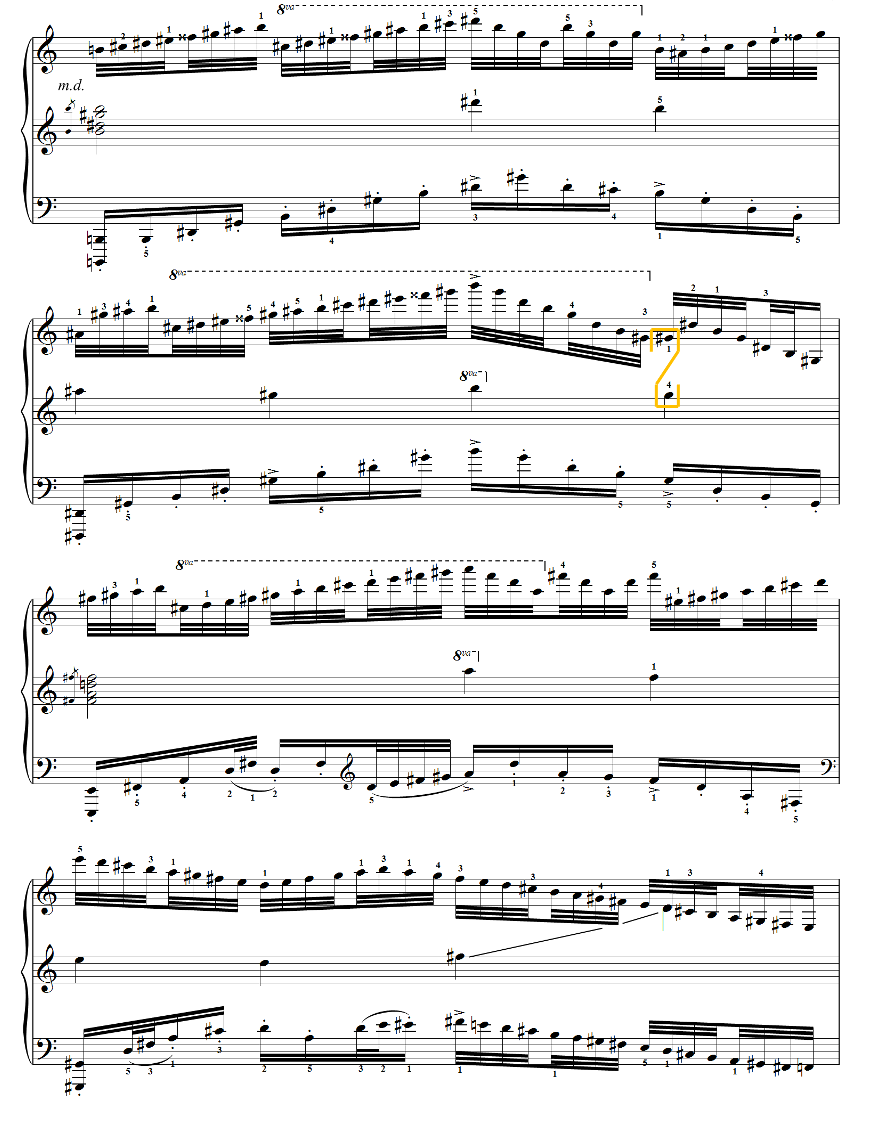“If a ninth is comfortable for your left hand, I recommend this rearrangement which requires less shifting in the right hand.”
Submitted by Michael Clark
Published on 1/3/2021

“If a ninth is comfortable for your left hand, I recommend this rearrangement which requires less shifting in the right hand.”
Submitted by Michael Clark
Published on 1/3/2021

“The right hand can easily take the F to allow the left hand more time for its position shift.”
Submitted by Michael Clark
Published on 1/3/2021

“I don’t mind start with 1 on a black key when it facilitates a consistent fingering pattern.”
Submitted by Michael Clark
Published on 1/3/2021

“This redistribution eliminates a stretch and can facilitate voicing of the alto melody.”
Submitted by Michael Clark
Published on 1/3/2021

“In such a low range, I prefer to start the grace notes as an octave. It also simplifies the groupings in the right hand.”
Submitted by Michael Clark
Published on 1/3/2021

“Taking the lower note in LH allows for the small (agate-type) notes to re-articulate precisely.”
Submitted by Sam Welsh
Published on 3/26/2020

“Hammering the upper notes with the thumb helps the student resist playing this passage legato, and keeps the hand open for the upcoming passage in ninths.”
Submitted by Sam Welsh
Published on 3/26/2020

“These simple left hand redistributions take the pressure off the right hand slightly.”
Submitted by Michael Lenahan
Published on 5/25/2020

“The redistribution at the end of the 2nd measure is a lifesaver! Take the G-sharp in the top staff with the left hand as an octave, so the right just plays a repeated G-sharp with 3 and 4.”
Submitted by Michael Lenahan
Published on 5/25/2020

“The double 4s and double 5 in the LH should be played with a high wrist on the downbeat. Taking the C's with a right hand octave helps a lot.”
Submitted by Michael Lenahan
Published on 5/25/2020
Original:

Suggested performance:

“I hate playing interlocked chords with the thumbs crossing. I get rid of most of them in this section.”
Submitted by Michael Lenahan
Published on 5/25/2020

“Taking the top note of these left hand chords with the right hand is a lot easier than leaping with the left hand to a repeated note.”
Submitted by Michael Lenahan
Published on 5/25/2020
Original:

Suggested performance:

“This is the most unreasonable and impossible part of the piece. I find no shame in playing the right-hand B an octave higher. By doing so, the left hand is leaping up to the same note the right hand was playing. I recommend bracing the left hand 2 by making a fist.”
Submitted by Michael Lenahan
Published on 5/25/2020

“Taking this fourth with the left hand makes playing legato in the right hand easier.”
Submitted by Michael Lenahan
Published on 5/25/2020

“The most straightforward way to play the double notes would be 5-3 4-2 3-1. However, using 5-1 4-2 3-1 provides better support and power to execute the accents. It also improves the clarity and prevents potential sloppiness.”
Submitted by Jimmy Cheung
Published on 4/27/23

“Splitting up this accompaniment (and the grace notes in particular) between the hands allows an even stronger, more pesante delivery.”
Submitted by Michael Clark with thanks to Jennifer Hayghe
Published on 1/1/2020

“The E-natural fits easily into the left hand and allows a more legato delivery.”
Submitted by Michael Clark
Published on 1/1/2020

Submitted by Ben Pawlak
Published on 3/29/2020